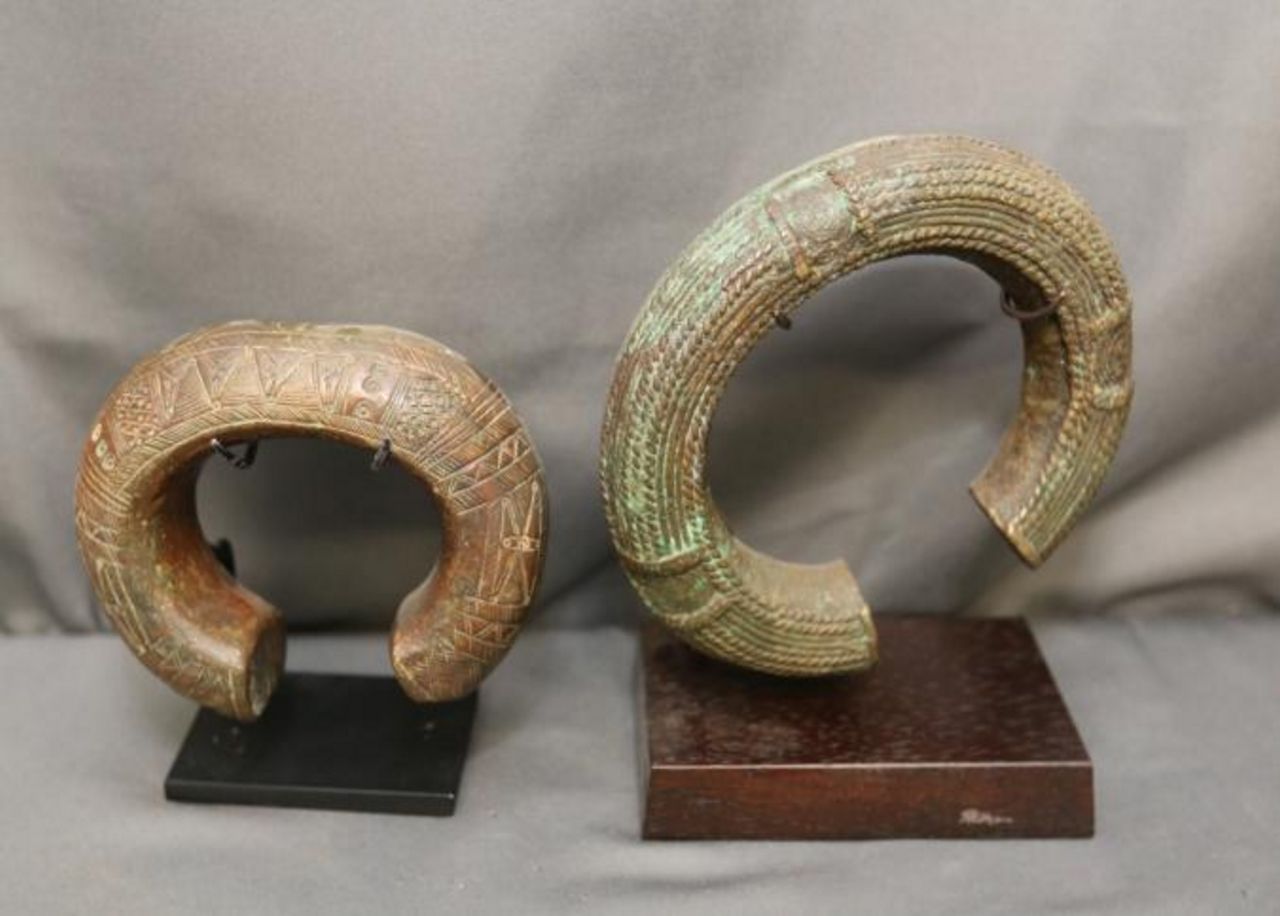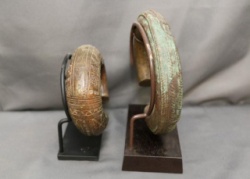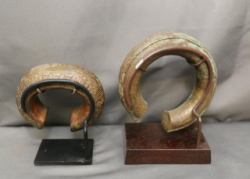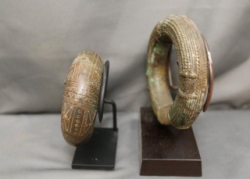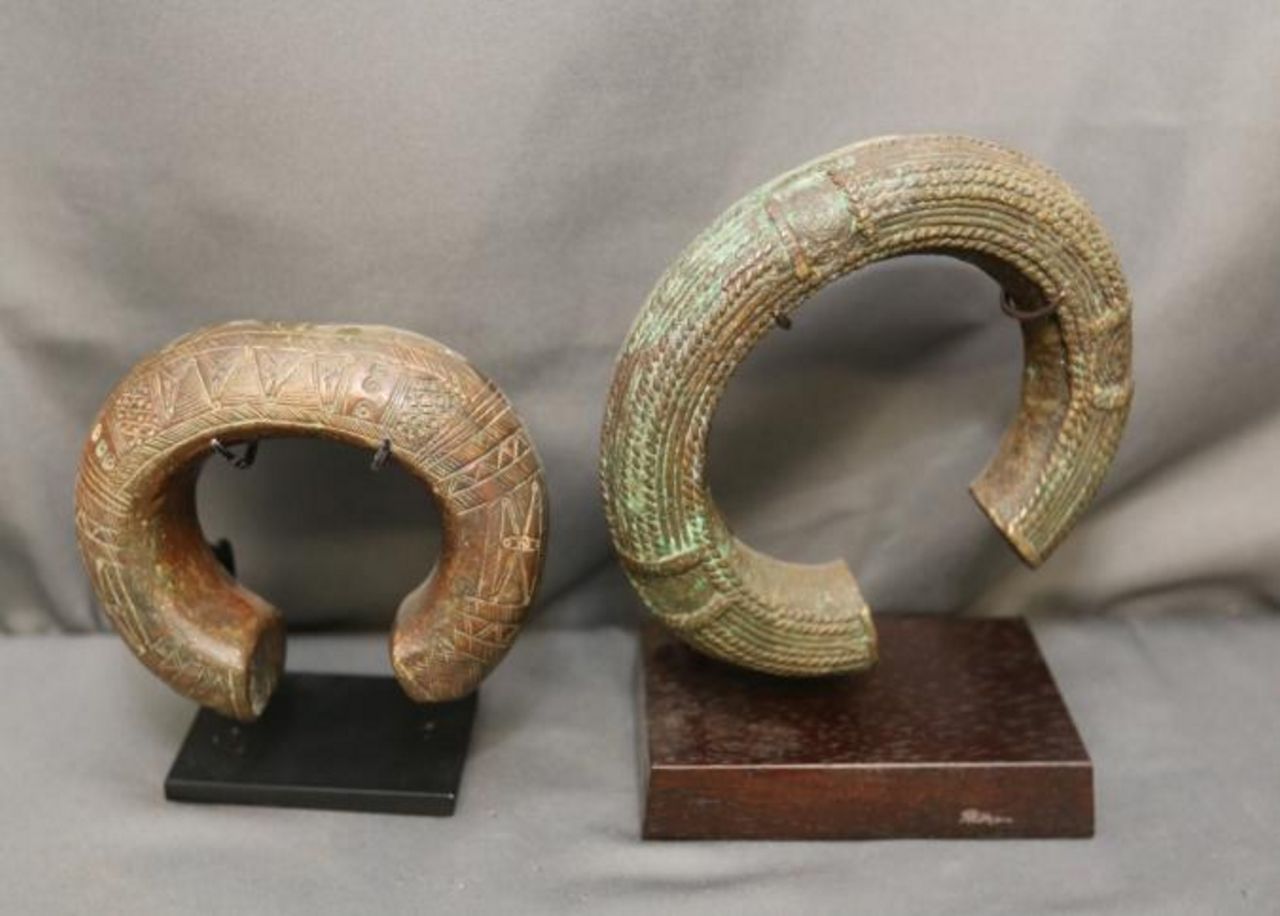Items located in Pleasant Valley, NY. Items include Asafo militia flag, Fante people, Ghana; gong rattle, Chamba people, Cameroon & Nigeria; blacksmith tools, Soninke people, Gambia; ceremonial fetish, Fon people; traditional women's hair pins, Bozo people, Mali; oil lamps, Dogon people, Mali; Cheetem rod currency, Anang people, Nigeria; wedding blanket, Fulani people, Mali or Niger; torque neck ring, Yoruba people, Nigeria; Cache Sexe ring, Kirdipeople, Cameroon & Northeast Nigeria; West African bells, Yoruba People, Nigeria; Duge necklaces, Dogon people, Mali and more.
AFRICAN ART COLLECTION OF MARY SUE AND PAUL PETER ROSEN
Mary Sue and Paul Peter Rosen have collected African art for over thirty years, making nine trips to Africa to study the art in its cultural setting. The Rosens have published three African art books, curated more than ten exhibitions from their collection, and have given public lectures about African art and culture. They have donated art from their collection to various institutions including the Newark Museum, Temple University in Philadelphia, the SMA Fathers African Art Museum in Tenafly, New Jersey, and the African American Research Library in Fort Lauderdale, Florida.
Payment is due by Friday, September 27 at 1PM.
Pickup in Pleasant Valley, NY must be completed by Friday, September 27 at 3PM.
All lots sold as is, where is. There is a 15% Buyers Premium for all lots purchased. Payment methods include cash, MC, Visa, Discover or good check. You can make credit card payment online by going to your Member Area and selecting your invoice.
*NOTE* Shipping is available on all items.
AFRICAN ART COLLECTION OF MARY SUE AND PAUL PETER ROSEN
Mary Sue and Paul Peter Rosen have collected African art for over thirty years, making nine trips to Africa to study the art in its cultural setting. The Rosens have published three African art books, curated more than ten exhibitions from their collection, and have given public lectures about African art and culture. They have donated art from their collection to various institutions including the Newark Museum, Temple University in Philadelphia, the SMA Fathers African Art Museum in Tenafly, New Jersey, and the African American Research Library in Fort Lauderdale, Florida.
Payment is due by Friday, September 27 at 1PM.
Pickup in Pleasant Valley, NY must be completed by Friday, September 27 at 3PM.
All lots sold as is, where is. There is a 15% Buyers Premium for all lots purchased. Payment methods include cash, MC, Visa, Discover or good check. You can make credit card payment online by going to your Member Area and selecting your invoice.
*NOTE* Shipping is available on all items.
Auction Info
Items located in Pleasant Valley, NY. Items include Asafo militia flag, Fante people, Ghana; gong rattle, Chamba people, Cameroon & Nigeria; blacksmith tools, Soninke people, Gambia; ceremonial fetish, Fon people; traditional women's hair pins, Bozo people, Mali; oil lamps, Dogon people, Mali; Cheetem rod currency, Anang people, Nigeria; wedding blanket, Fulani people, Mali or Niger; torque neck ring, Yoruba people, Nigeria; Cache Sexe ring, Kirdipeople, Cameroon & Northeast Nigeria; West African bells, Yoruba People, Nigeria; Duge necklaces, Dogon people, Mali and more.
AFRICAN ART COLLECTION OF MARY SUE AND PAUL PETER ROSEN
Mary Sue and Paul Peter Rosen have collected African art for over thirty years, making nine trips to Africa to study the art in its cultural setting. The Rosens have published three African art books, curated more than ten exhibitions from their collection, and have given public lectures about African art and culture. They have donated art from their collection to various institutions including the Newark Museum, Temple University in Philadelphia, the SMA Fathers African Art Museum in Tenafly, New Jersey, and the African American Research Library in Fort Lauderdale, Florida.
Payment is due by Friday, September 27 at 1PM.
Pickup in Pleasant Valley, NY must be completed by Friday, September 27 at 3PM.
All lots sold as is, where is. There is a 15% Buyers Premium for all lots purchased. Payment methods include cash, MC, Visa, Discover or good check. You can make credit card payment online by going to your Member Area and selecting your invoice.
*NOTE* Shipping is available on all items.
AFRICAN ART COLLECTION OF MARY SUE AND PAUL PETER ROSEN
Mary Sue and Paul Peter Rosen have collected African art for over thirty years, making nine trips to Africa to study the art in its cultural setting. The Rosens have published three African art books, curated more than ten exhibitions from their collection, and have given public lectures about African art and culture. They have donated art from their collection to various institutions including the Newark Museum, Temple University in Philadelphia, the SMA Fathers African Art Museum in Tenafly, New Jersey, and the African American Research Library in Fort Lauderdale, Florida.
Payment is due by Friday, September 27 at 1PM.
Pickup in Pleasant Valley, NY must be completed by Friday, September 27 at 3PM.
All lots sold as is, where is. There is a 15% Buyers Premium for all lots purchased. Payment methods include cash, MC, Visa, Discover or good check. You can make credit card payment online by going to your Member Area and selecting your invoice.
*NOTE* Shipping is available on all items.
Categories:
TWO BRACELET-FORM MANILLAS. Yoruba people, Nigeria. Manillas are a diverse group of iron, brass, and copper objects with semicircular C-shapes, U-shapes and elongated U-shapes, as well as coils and rings. The name manilla has been attributed to the word manilho or manillol meaning bracelet. Most manillas were manufactured in European countries and transported to Africa to be exchanged for various goods, including gold, ivory and slaves. They were usually made by pouring molten metal into molds. Decorative surface designs were sometimes built into the molds to increase the value of manillas or they were added by African blacksmiths. Manillas with decorated surfaces were highly prized to be used for ceremonial purposes or hoarded and buried for safe keeping. (A) C-shaped manilla with surface decoration added during casting. Said to have been excavated from a hoard in the 1960s which explains the verdigris patina. On custom base. Brass. Diameter 5.5". (B) C shaped manilla with inscribed surface decoration added by an African blacksmith. Designs consist of lines forming triangles and punched circles. Dates from early 19th century. On custom base. Diameter 4. 5in. 31b. Exhibited at the Pen and Brush Gallery New York 2003.
More Details
TWO BRACELET-FORM MANILLAS. Yoruba people, Nigeria. Manillas are a diverse group of iron, brass, and copper objects with semicircular C-shapes, U-shapes and elongated U-shapes, as well as coils and rings. The name manilla has been attributed to the word manilho or manillol meaning bracelet. Most manillas were manufactured in European countries and transported to Africa to be exchanged for various goods, including gold, ivory and slaves. They were usually made by pouring molten metal into molds. Decorative surface designs were sometimes built into the molds to increase the value of manillas or they were added by African blacksmiths. Manillas with decorated surfaces were highly prized to be used for ceremonial purposes or hoarded and buried for safe keeping. (A) C-shaped manilla with surface decoration added during casting. Said to have been excavated from a hoard in the 1960s which explains the verdigris patina. On custom base. Brass. Diameter 5.5". (B) C shaped manilla with inscribed surface decoration added by an African blacksmith. Designs consist of lines forming triangles and punched circles. Dates from early 19th century. On custom base. Diameter 4. 5in. 31b. Exhibited at the Pen and Brush Gallery New York 2003.
High Bid:
$130.00 – ibuythings
Auction Type: One Lot
Quantity: 1
Bidding has closed on this lot

